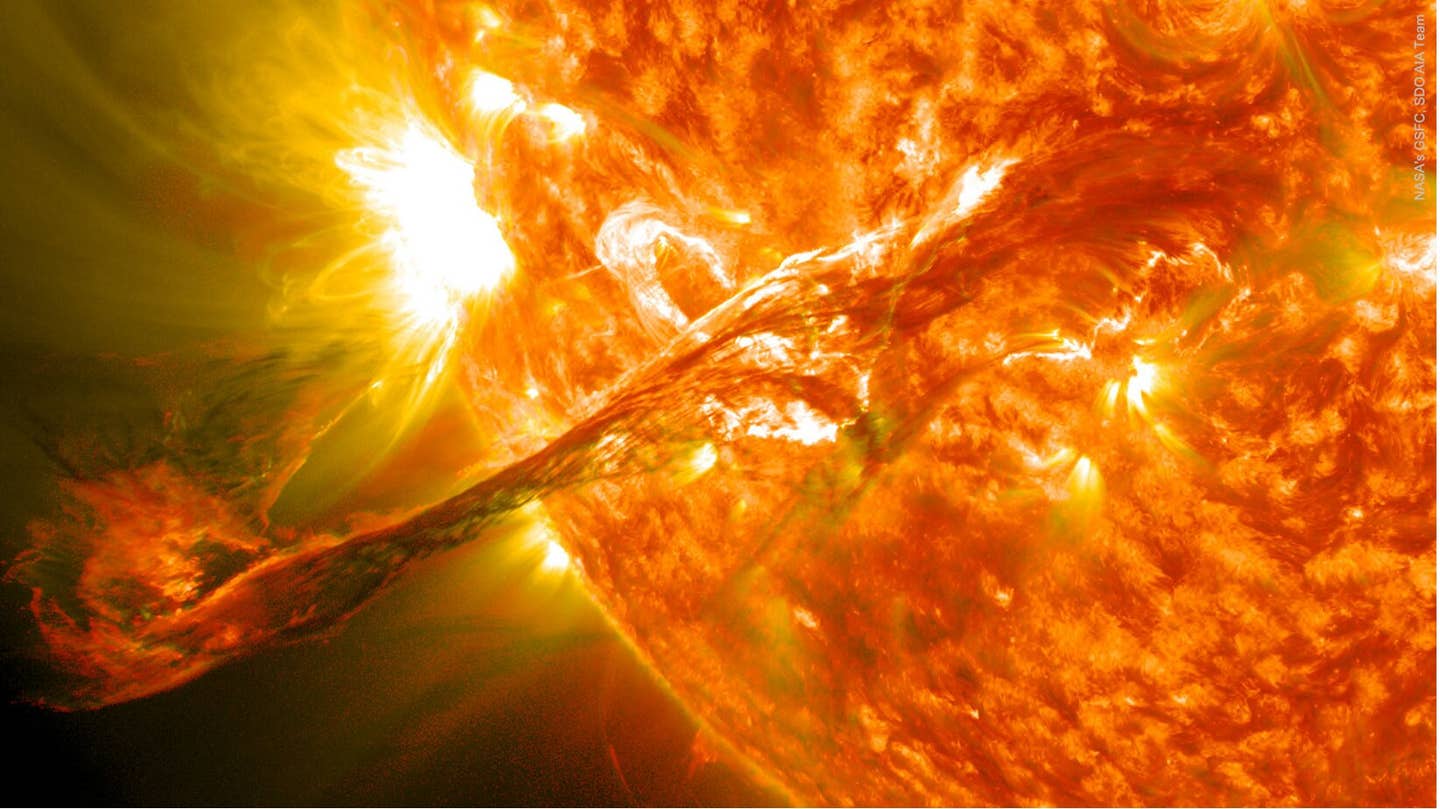Researchers solve 20-year-old paradox in solar physics
Researchers found the solution to an intriguing paradox, opening up a new window for exploring the elusive magnetic fields of stars

[August 19, 2021: Università della Svizzera italiana]
Image of the solar atmosphere showing a coronal mass ejection. (Credit: NASA/GSFC/SDO)
In 1998, the journal Nature published a seminal letter concluding that a mysterious signal, which had been discovered while analyzing the polarization of sunlight, implies that the solar chromosphere (an important layer of the solar atmosphere) is practically unmagnetised, in sharp contradiction with common wisdom. This paradox motivated laboratory experiments and theoretical investigations, which instead of providing a solution, raised new issues, and even led some scientists to question the quantum theory of matter-radiation interaction.
Today, researchers at the Istituto Ricerche Solari (IRSOL) in Locarno-Monti (affiliated to USI Università della Svizzera italiana), and the Instituto de Astrofísica de Canarias (IAC) in Tenerife, have found the solution to this intriguing paradox, opening up a new window for exploring the elusive magnetic fields of the solar chromosphere in the present new era of large-aperture solar telescopes. Their findings are published in Physical Review Letters.
Twenty-five years ago, an enigmatic signal was discovered while analyzing the polarization of sunlight with a new instrument, the Zurich Imaging Polarimeter (ZIMPOL), developed at ETH Zurich and later installed at IRSOL. This mysterious linear polarization signal, produced by scattering processes, appears at the wavelength of a neutral sodium line (the so-called D1 line), where, according to quantum mechanics, no such scattering polarization should be present. This signal was therefore totally unexpected, and its interpretation immediately opened an intense scientific debate.
The mystery further increased two years later, when the journal Nature published an explanation implying that the layer of the solar atmosphere known as the chromosphere is completely unmagnetised, in apparent contradiction with established results; researchers believed that (outside sunspots) this region is permeated by magnetic fields in the gauss range. The new findings opened a serious paradox that has challenged solar physicists for many years, and even led some scientists to question the available quantum theory of matter-radiation interaction.
Now, in an article published by Physical Review Letters, Ernest Alsina Ballester (IRSOL, IAC), Luca Belluzzi (IRSOL), and Javier Trujillo Bueno (IAC) show the solution to this intriguing paradox. The findings were achieved by carrying out the most advanced theoretical modeling of the solar D1 line polarization ever attempted, involving three years of work carried out through a close cooperation between the Istituto Ricerche Solari (IRSOL) in Locarno-Monti (affiliated to USI Università della Svizzera italiana) and the POLMAG group of the Instituto de Astrofísica de Canarias (IAC) in Tenerife.
The researchers explain: "This result has very important consequences. Scattering polarization signals, like the one observed in the D1 line of sodium, are extremely interesting because they encode unique information on the elusive magnetic fields present in the solar chromosphere. This key interface layer of the solar atmosphere, located between the underlying cooler photosphere and the overlying million-degree corona, is at the core of several enduring problems in solar physics, including the understanding and prediction of the eruptive phenomena that may strongly impact our technology-dependent society.
The magnetic field is known to be the main driver of the spectacular dynamical activity of the solar chromosphere, but our empirical knowledge of its intensity and geometry is still largely unsatisfactory. The solution of the long-standing paradox of solar D1 line polarization proves the validity of the present quantum theory of spectral line polarization, and opens up a new window to explore the magnetism of the solar atmosphere in the present new era of large-aperture solar telescopes."
Like these kind of feel good stories? Get the Brighter Side of News' newsletter.
Tags: #New_Discoveries, #Stars, #Space, #Astronomy, #Physics, #The_Brighter_Side_of_News
Joshua Shavit
Science & Technology Writer | AI and Robotics Reporter
Joshua Shavit is a Los Angeles-based science and technology writer with a passion for exploring the breakthroughs shaping the future. As a contributor to The Brighter Side of News, he focuses on positive and transformative advancements in AI, technology, physics, engineering, robotics and space science. Joshua is currently working towards a Bachelor of Science in Business Administration at the University of California, Berkeley. He combines his academic background with a talent for storytelling, making complex scientific discoveries engaging and accessible. His work highlights the innovators behind the ideas, bringing readers closer to the people driving progress.



